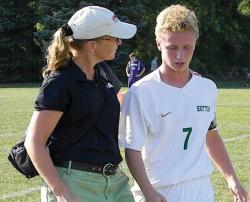
Article reposted from The Millbury Sutton Chronicle
Author: Robert Fucci
When you work for a public school system as small as Sutton’s, you have to find ways to be creative when it comes to budgeting items you deem important to student life.
Athletic Director Christina Tuomala, now in her second year, recently found that out first hand when trying to figure out how to make her student-athletes safer while on the field of play.
Last summer, Tuomala discussed with Superintendent Ted Friendand the School Committee about bringing in hired athletic trainers to certain varsity games for this school year. She said she started looking into budgeting for athletic trainers last October.
“I noticed we had budgeted EMTs and then I noticed in the (MIAA) rules that we could have trainers. Nipmuc had a brand new athletic director who said he was going with trainers,” she said. “I asked him to give me some info and I contacted Precision Athletic Training and asked them to get me a write-up of what it would cost us. Then I put that into our budget, which was due in November last year for this year.”
Her persuasion worked.
“She talked about the advantages of having athletic trainers vs EMTs,” Friend said. “Because they would be there the whole time, athletic trainers can provide immediate attention. There were cost savings, so it’s kind of a no-brainer. You get direct care for the athletes on the field.”
According to the Massachusetts Interscholastic Athletic Association (MIAA), which governs high school athletics in the Commonwealth, each member school should employ a licensed certified athletic trainer. Licensed physicians, trainers, and coaches should receive sport medicine training and must have medical coverage at all football and varsity boys and girls ice hockey games per sport rules.
The MIAA also mandates a licensed physician, licensed trainer or certified EMT must be in attendance and on duty for all interscholastic football games.
“We were hiring a full ambulance unit for varsity games and EMTs for JV games,” Tuomala said. “I was catching wind from the MIAA that maybe athletic trainers are the way we’re going because athletic trainers can assess on the field if a student is injured, can be treated and then sent back on the field, or if they are injured take them off the field and out of the game. If an EMT goes onto the field, that student is taken out of the game and won’t return, no matter what.”
After getting the green light from Friend and the School Committee, Tuomala wound up signing a membership with Precision Athletic Training, based out of Lynnfield.
“This is the first time we’ve put it in the budget for an athletic trainer as a line item,” she said, adding the athletic trainers get paid an hourly rate. “We can hire them whenever we want or need them.”
The decision to change over to athletic trainers was purely for the student-athletes.
“I wanted to try and get students the opportunity to get back on the field, if possible,” Tuomala said. “If someone treats them the way they need to be treated on the side of the field, (a trainer can decide whether they) go back out.”
The threat of concussions also played a key role in the decision-making.
“An athletic trainer can assess and diagnose, if necessary, a concussion and recommend to a parent to either bring them to an emergency room, call an ambulance or allow them time to rest and then give them protocol over the next few days,” she said.
This fall, SHS will have athletic trainers at all of its home soccer games and JV football games. If the school is hosting multiple home games at different venues, Tuomala said she would likely hire two separate trainers.
“We’ve budgeted for boys and girls varsity home games no matter the dates,” she said.
The transition over to athletic trainers paid off during the first week of play in September during the boys soccer home opener againstShepherd Hill. Two athletes, one from each team, got injured before the game started. A Sutton athlete suffered a broken nose while a Shepherd Hill player sprained an ankle.
“(The athletic trainer) was able to assess both those individuals before the game and decided whether to let them play or not,” Tuomala said. “The boy with the broken nose went to the emergency room and the boy with the sprained ankle was on the sidelines.”
Tuomala said her budget will allow for athletic trainers through the winter season.
Larger school districts in Massachusetts actually hire athletic trainers to be on campus on a regular basis.
“I know that almost all of the school districts in eastern Massachusetts have full-time or parttime athletic trainers where they are on campus all the time,” Tuomala said. “They have a room for their benches. I would love to go toward a part-time athletic trainer here all the time, from 2-6 p.m. or (whenever) we have events, so they can assess our students during practices, warm-ups, tryouts, things like that. I’m already investigating for next year what she needs to put in the budget, five days a week from 2-6 p.m.”
Friend said meeting that goal will be challenging.
“In an ideal world, we’d have a full-time athletic trainer. But we’re a small district,” he said. “A district like Wachusett, which has 2,000 students, has a full-time athletic trainer. We have only 400 at the high school. We’ve been in tight economic times for the last seven years. I don’t see us adding to the budget for even a half-time position. We’re still ways away from coming out of this difficult financial time. Do I see us in the future adding (our own athletic trainer)? If we see increased funding in certain areas, it’s something we would add. But it’s below other priorities.”
